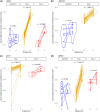Impact of the acquired subgenome on the transcriptional landscape in Brettanomyces bruxellensis allopolyploids
- PMID: 37226280
- PMCID: PMC10320193
- DOI: 10.1093/g3journal/jkad115
Impact of the acquired subgenome on the transcriptional landscape in Brettanomyces bruxellensis allopolyploids
Abstract
Gene expression variation can provide an overview of the changes in regulatory networks that underlie phenotypic diversity. Certain evolutionary trajectories such as polyploidization events can have an impact on the transcriptional landscape. Interestingly, the evolution of the yeast species Brettanomyces bruxellensis has been punctuated by diverse allopolyploidization events leading to the coexistence of a primary diploid genome associated with various haploid acquired genomes. To assess the impact of these events on gene expression, we generated and compared the transcriptomes of a set of 87 B. bruxellensis isolates, selected as being representative of the genomic diversity of this species. Our analysis revealed that acquired subgenomes strongly impact the transcriptional patterns and allow discrimination of allopolyploid populations. In addition, clear transcriptional signatures related to specific populations have been revealed. The transcriptional variations observed are related to some specific biological processes such as transmembrane transport and amino acids metabolism. Moreover, we also found that the acquired subgenome causes the overexpression of some genes involved in the production of flavor-impacting secondary metabolites, especially in isolates of the beer population.
Keywords: Brettanomyces bruxellensis; polyploids; subgenome; transcriptional landscape; yeast.
© The Author(s) 2023. Published by Oxford University Press on behalf of The Genetics Society of America.
Conflict of interest statement
Conflicts of interest statement The author(s) declare no conflict of interest.
Figures





Similar articles
-
Whole-genome sequencing of 1,060 Brettanomyces bruxellensis isolates reveals significant phenotypic impact of acquired subgenomes in allopolyploids.Nat Commun. 2025 Jul 1;16(1):5500. doi: 10.1038/s41467-025-60706-4. Nat Commun. 2025. PMID: 40595487 Free PMC article.
-
Brettanomyces bruxellensis: Overview of the genetic and phenotypic diversity of an anthropized yeast.Mol Ecol. 2023 May;32(10):2374-2395. doi: 10.1111/mec.16439. Epub 2022 Apr 4. Mol Ecol. 2023. PMID: 35318747 Review.
-
High Complexity and Degree of Genetic Variation in Brettanomyces bruxellensis Population.Genome Biol Evol. 2020 Jun 1;12(6):795-807. doi: 10.1093/gbe/evaa077. Genome Biol Evol. 2020. PMID: 32302403 Free PMC article.
-
Genomics Perspectives on Metabolism, Survival Strategies, and Biotechnological Applications of Brettanomyces bruxellensis LAMAP2480.J Mol Microbiol Biotechnol. 2017;27(3):147-158. doi: 10.1159/000471924. Epub 2017 Jun 9. J Mol Microbiol Biotechnol. 2017. PMID: 28595177
-
Genomic insights into the evolution of industrial yeast species Brettanomyces bruxellensis.FEMS Yeast Res. 2014 Nov;14(7):997-1005. doi: 10.1111/1567-1364.12198. Epub 2014 Sep 15. FEMS Yeast Res. 2014. PMID: 25142832 Review.
Cited by
-
Subpopulation-specific gene expression in Lachancea thermotolerans uncovers distinct metabolic adaptations to wine fermentation.Curr Res Food Sci. 2024 Dec 11;10:100954. doi: 10.1016/j.crfs.2024.100954. eCollection 2025. Curr Res Food Sci. 2024. PMID: 39760014 Free PMC article.
-
Whole-genome sequencing of 1,060 Brettanomyces bruxellensis isolates reveals significant phenotypic impact of acquired subgenomes in allopolyploids.Nat Commun. 2025 Jul 1;16(1):5500. doi: 10.1038/s41467-025-60706-4. Nat Commun. 2025. PMID: 40595487 Free PMC article.
References
-
- Avramova M, Cibrario A, Peltier E, Coton M, Coton E, Schacherer J, Spano G, Capozzi V, Blaiotta G, Salin F, et al. . Brettanomyces bruxellensis population survey reveals a diploid–triploid complex structured according to substrate of isolation and geographical distribution. Sci Rep. 2018;8(1):1–13. doi:10.1038/s41598-018-22580-7. - DOI - PMC - PubMed
-
- Avramova M, Grbin P, Borneman A, Albertin W, Masneuf-Pomarède I, Varela C. Competition experiments between Brettanomyces bruxellensis strains reveal specific adaptation to sulfur dioxide and complex interactions at intraspecies level. FEMS Yeast Res. 2019;19(3):1–9. doi:10.1093/femsyr/foz010. - DOI - PubMed
Publication types
MeSH terms
Supplementary concepts
LinkOut - more resources
Full Text Sources
